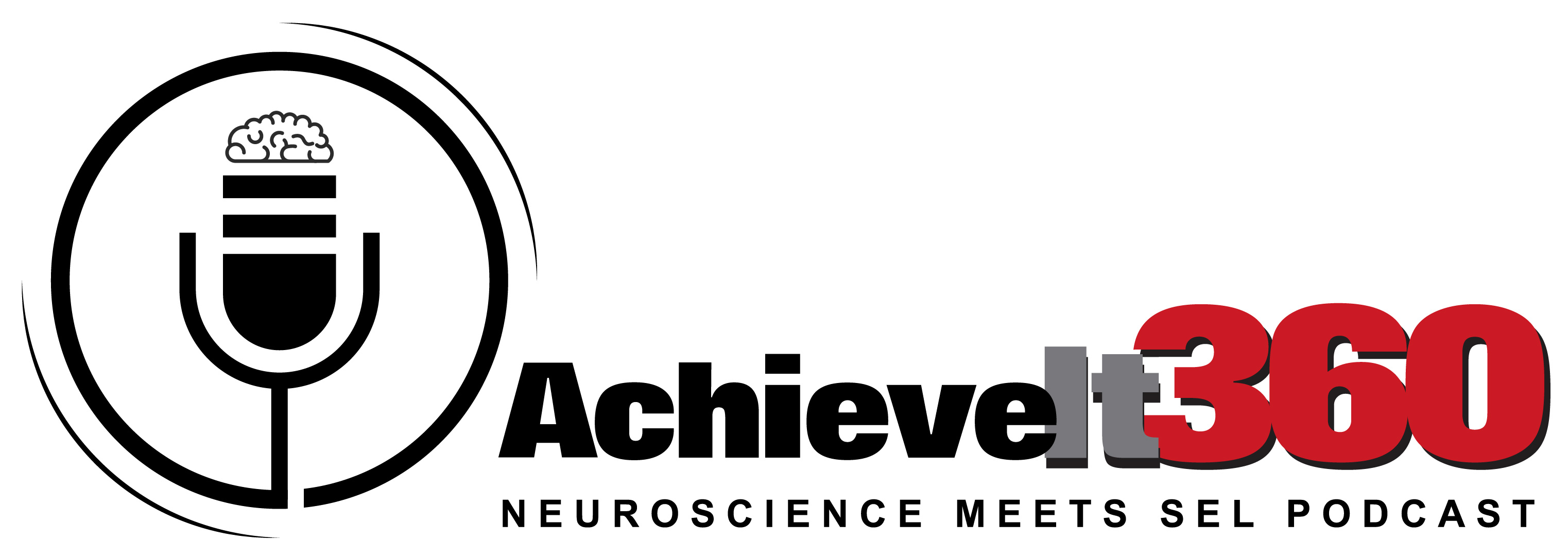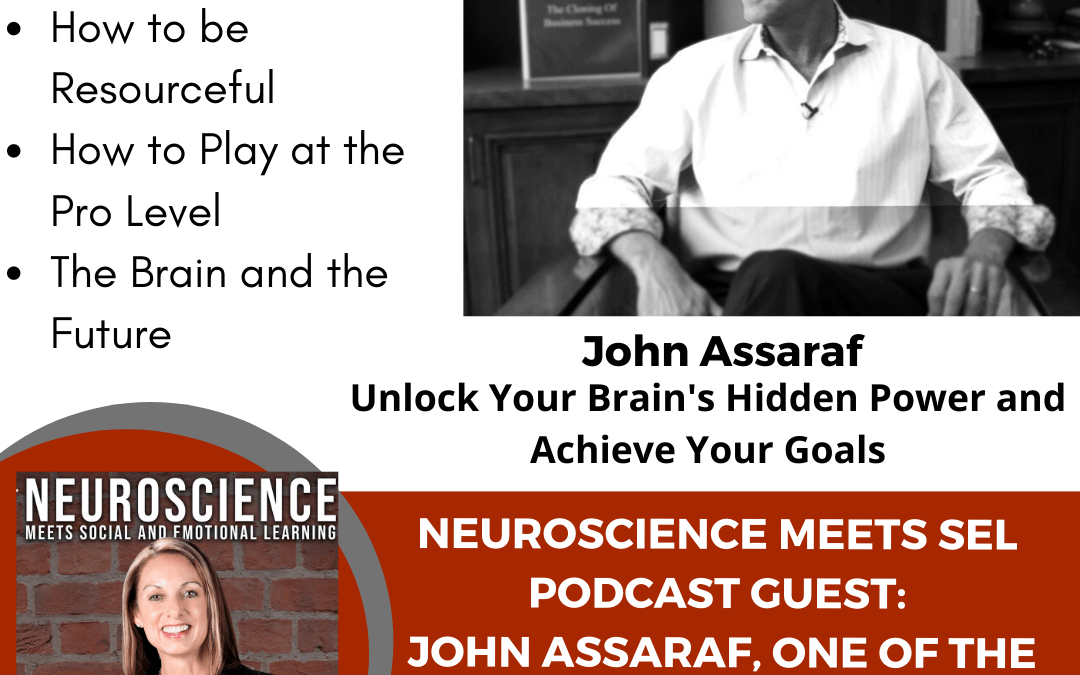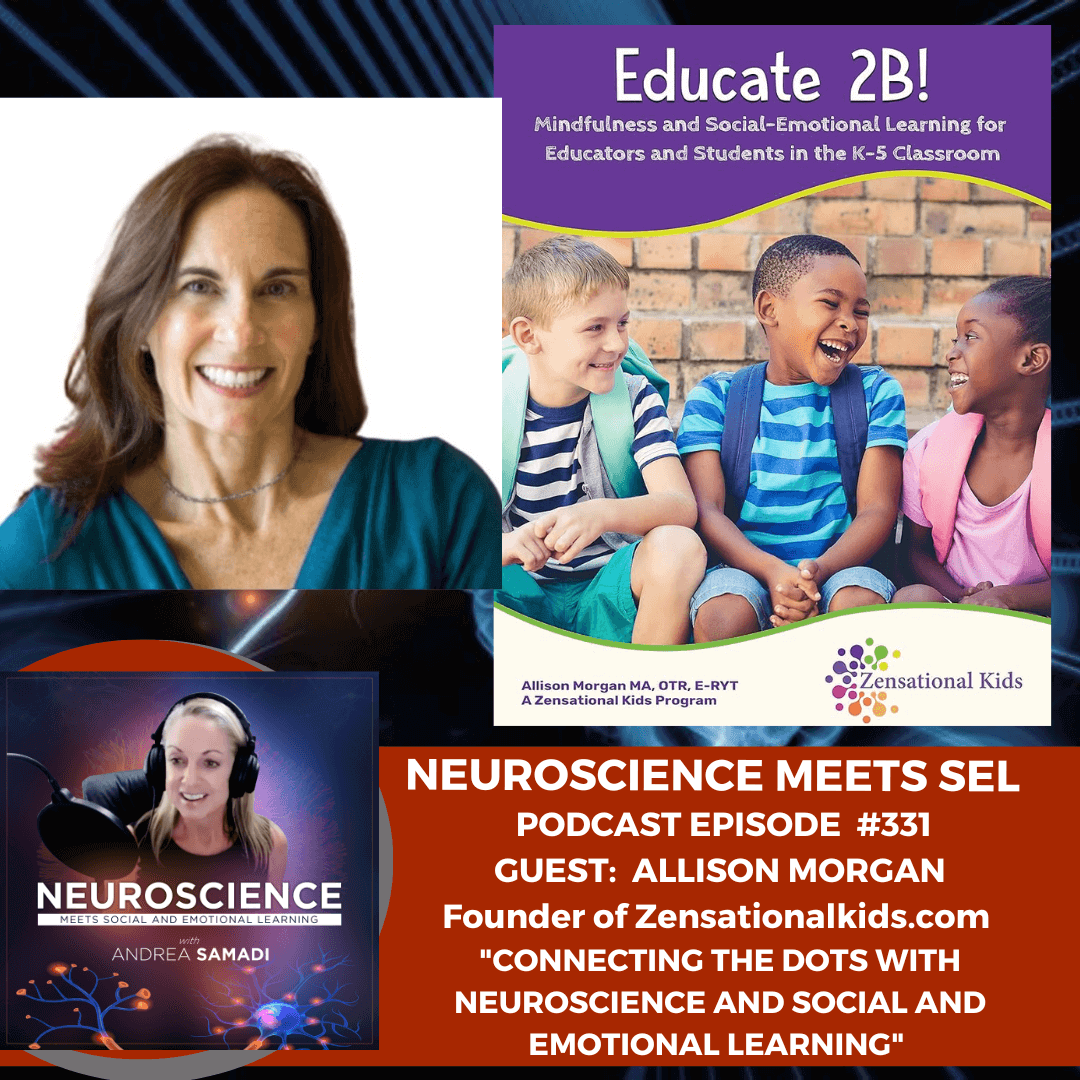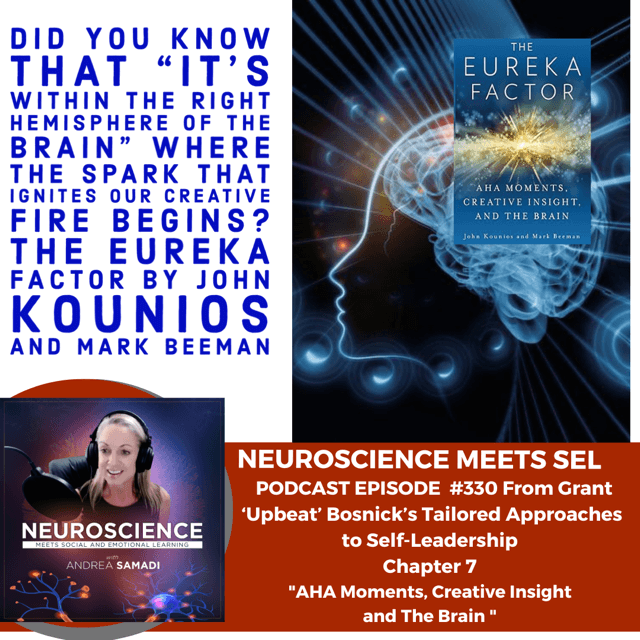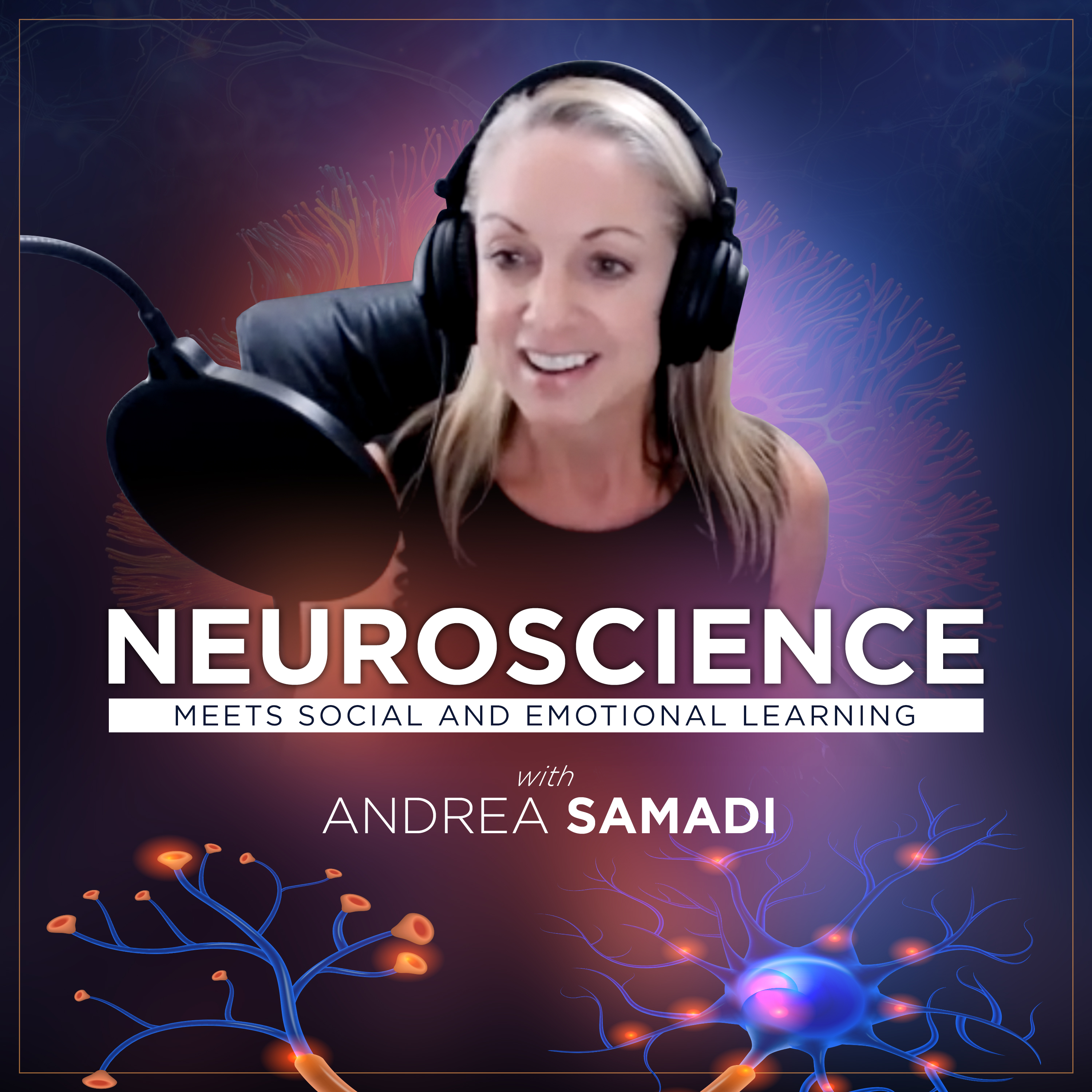This is episode #32 with John Assaraf, one of the leading mindset and behavior experts in the world, who has appeared numerous times on Larry King Live, Anderson Cooper and The Ellen DeGeneres Show. You can watch this Flashback interview on YouTube.
Welcome to the “Neuroscience Meets SEL” podcast, my name is Andrea Samadi, a former educator who has been fascinated with understanding the science behind high performance strategies in schools, sports and the workplace for the past 20 years. Today we have John Assaraf—he has built 5 multimillion-dollar companies, written 2 New York Times Bestselling books and has been featured in 8 movies, and today, he is the founder and CEO of NeuroGym, a company dedicated to using the most advanced technologies and evidence based brain training methods to help individuals unleash their fullest potential and maximize their personal and professional results.
In 2014 when my company was awarded grant funding to run character programs in Arizona schools, I knew I needed to find someone who had a proven path for business success to make sure I had the right systems in place, so I immediately looked up John to see what courses he was teaching and applied to join his “Cloning for Business Success Class” that he was teaching at the time. For those interested, you can see a similar business acceleration mastermind he is currently accepting applications for called The Escape Velocity Mastermind.[i] I had no idea that this class would lead me to brain-training (I was given a FREE course to try that has been a part of my daily routine for the past 6 years), and that this decision would lead me to Mark Robert Waldman, and eventually adding the most current neuroscience research to my programs. It all started with John and with anyone who has met him, or knows his work, you would know that this was a pivotable point in my career as he has such a wealth of knowledge, is an expert at helping people change their behaviors to get the results they want, and he sincerely wants to see other people succeed.
To learn more about John, go to www.myneurogym.com and enjoy this Flashback interview from 2016. Keep in mind this was 4 years ago, when he speaks about research that has just emerged. We apologize for the sound quality, but sure you will agree with me that this information is powerful.
[i] See John’s most current course Escape Velocity 212 Mastermind http://links.myneurogym.com/EV212
Andrea Samadi: So John, can you explain your story. What were you doing that wasn’t working and what made you decide to choose a different path for your life?
John Assaraf: You talking about when I was younger, the kid getting myself into a whole lot of trouble.
Andrea Samadi: Yes. What made you decide to move past that and stop going that direction that you were going, to the pathway that you’re on now?
John Assaraf: Well, I grew up with loving parents who taught me right from wrong. What they didn’t teach me is how to overcome or even recognize my low self-esteem and that I didn’t think I was smart enough or good enough and I don’t think, they knew that I thought that way. And I don’t, no. That they have the tools to know themselves to grade three and grade five is where my parents finished school. I knew that when I was getting myself into a lot of trouble and that it was the wrong thing to do. But I also didn’t know that there was a better way. And it wasn’t until I was 19 years old where I met a mentor, somebody who saw a good young kid who was just doing the wrong things. That showed me that there was a different path and he showed me that I could do something that I really loved to do instead of doing what I thought I had to do, which is well, and I had a job, a company that was an electronics company is Phillips Electronics.
John Assaraf: And that as the scenario, you know, for eight hours a day and the little three by five cards writing when inventory came in and when inventory went out, and that was, it was mindless. And so I knew that I didn’t want that, but I also didn’t know that there were other options for me. So the first thing that he did was he had me, Oh, if I could do other things, what would it be? What would my life be like? What would I feel like? What would I be doing? Where would I be going? Who would I be helping? And as soon as I started to think about that side of it, even though I didn’t know how, even though I didn’t have the knowledge or the skills, he then said, well, those who gain after you decide what it is you really would love to do.
John Assaraf: And so he gave me a little glimpse, of hope. And then he backed off of the hope with a plan. And every day he had me focusing on my goals every day have me listening to (back then)cassette tapes every day have me reading things that fertilized my mind, and showed me how people overcome obstacles, how people can overcome their lack of confidence or certainty. They’re not good enough or smart enough or deserving enough. And each day he showed me that it was possible. And in him guiding me and him loving me and caring about me to take this time to show me the path, I started to see that maybe I could. And then my maybe turned into a lot more. And I started to learn the process, but I never learned before for self-acceptance or self-love for gaining more knowledge and upgrading my skills because I was never afraid of work. I was just doing the wrong work. I was never afraid of thinking. I was just thinking the wrong things. I was never afraid of my emotions, but I just didn’t know what to do with the ones that I had.
Andrea Samadi: Wow, everyone can have access to your mentor. That changes your thinking.
John Assaraf: But that’s the work I do today with understanding, you know, many of these concepts. No, they’re real life things that we can start to help individuals understand. At 19 he put me on a path, learning how I could become more so I could do more and give more and heal more. And it’s been a journey of learning and growing and overcoming obstacles and achieving some great successes, favorable, wonderful failures that, you know, are some of my best lessons and all of that. You know, the painting of my life has been developed and that that’s what makes the smiles. It’s all the good, the bad, the ugly, the challenging, the amazing, the downright, Oh my gosh. And and ashamed and guilty and, and blame and all of that stuff. And learning how to navigate through that is really what helped me.
Andrea Samadi: Wow, that’s a great, great story and excellent lessons. What are some strategies that really helped you because I know a lot of people have an idea, they set goals and then they only know what they know. I know how you found a mentor, but how, how would just any regular person out there figure out what to do next?
John Assaraf: Yeah, I think there’s a couple of fundamentals that are really critical.
John Assaraf: Machio Kaku, a quantum scientist from New York University who is being interviewed with a group of other people on what is genius. And he said something really profound and he said in his University, he has many childs prodigy toward geniuses and let’s say mathematics or physics. And it says a genius in an area without the will to the drive, succeed in the past, succeed will fizzle out. And so one of the things that I learned early on was setting goals is one part of the equation. And while I’m talking to you, I’m going to get up because I just saw a signal that my battery was dying. So give me one second.
John Assaraf: And I will, just plug in my computer and then, okay, excellent, share while I shift my office here. And so a couple of things that I, realized, that I think sports gave me the benefit of, was the power of repetition. So if you were to learn the alphabet, if you were to learn how to walk, if you’re to learn, language or your low spots to learn guitar there are the basics. You practice the basics, which allows you to then move to a little bit more complex, know the activity or action, which allows you to go from knowing, conscious effort to unconscious competence. And so I learned the power of perfect practice when I was very, very young because you have to practice the layup perfectly. You have to practice getting the puck in the net for hockey perfectly.
John Assaraf: You have to practice doing it right, not just doing it. So when I’ve gone into the world of business and the world of sales and the world, I wasn’t afraid to practice and to fail and to stand back up. But I also learned a really important lesson. And that was around being resourceful when you don’t have resources. Yes. So one of my earliest lessons when I was 16 years old is I wanted to go to basketball camp and my family didn’t have money to send me to a basketball game. I lived in Montreal, basketball camp was in New York. It was with a professional basketball player. And the camp was like, you know, $1,000 and my family couldn’t afford $1,000. And so somebody said to me, well, why don’t you just see if you could work at the camp. So I called the campus and said “Hey, is there work?”
John Assaraf: The camp said, “no.” I said, “I really want to come to the camp. What can I do to come to the camp?” And I remember the gentleman’s name, Alex Robinson, I’m telling you this is 39 years ago. 39 years ago, Alex Robinson said to me, “I’ll let you come for a discounted price if you can bring four other kids with you.” I said, “okay.” So I started to ask every kid that I knew who may want to go to camp, to go to basketball camp. That’s why I got all the kids and they paid, their parents, paid for them. And Alex let me come to basketball camp for $500 of which I paid $250 because I had a paper route and my father and mother came up with the other $250. The point that I want to make is when you don’t have resources, you have to think of being resourceful. And there are so many ways to achieve something. So if you need knowledge or information, Google it, go to Coursera, go to all of the places that offer free knowledge and information. Start there if you need, in order to upgrade your knowledge and skills on sales, marketing, management, finance, health, relationships, career, business, spirituality, you don’t need to spend a nickel and you could keep busy for the next five years. That’s right.
John Assaraf: And nobody has, nobody has the right any more to say, you know, I can’t, I don’t know. it’s too hard. Baloney! And so resourcefulness is really, really, really critical. The other part of it was to learn how to not take rejection personally. And again, I’ll go back to when I was a kid. I wanted, to win the school raffle contest for selling the most raffle tickets. Some kids sold chocolates, but we sold raffle tickets, the deal you buy for a dollar or $5 for a book of 10, whatever the case is. And the first prize was a bicycle and my family couldn’t afford to buy me a bicycle. And so I was taught by the gym teacher how to ask people to buy raffle tickets. And so where most kids went “Hey, do you want to buy a raffle ticket?”
John Assaraf: I said, Hey, how would you like to help me win a bicycle while you help our school paint the murals in the school so we’d have a much more wonderful environment?” He taught me one line, one line! Some people don’t want to buy a raffel ticket. But it might help you, you know, win a bicycle, they might help the school paint the wall so that the environment is better for the kids. So in one simple sentence I was able to sell 5 or 10 times more raffle tickets than any other kid, because I asked for help. And that really is the second or third part of this is why are so many of us afraid to ask for help and say, “I don’t know. Could you please help me?” And the reason I suggest that is there are so many people with the knowledge, the skills, the contacts, the resources, the blueprint, the map, that want to help others.
John Assaraf: But they don’t ever get asked or people are just afraid because they’re afraid of being rejected. And so I learned many years ago that when people reject, they don’t reject you, 99.9% of the time they reject what you may have offered them. They may reject the product, the service the request, but not you. And rejection of a product, service or request is something that either works for them or doesn’t, but also could be that you didn’t ask the right way. And so that’s where hour yours my responsibility learn how to do whatever it is that we need to do at the highest level possible. And in the world that we live in, in the world of whether it’s sports, music, money, business,
John Assaraf: there are people that do at the kindergarten, okay. Level. I don’t mean teaching at the kindergarten level, but being in average kindergarten teacher, there are people that do it at a very, very, very high level. And I decided many years ago I want to play whatever game I was playing at a high level. And so playing at a high level is a decision that you need to make and then you need to reverse engineer. How do I need to think, what I need to feel What are the knowledge, what are the skills that I need to upgrade to play at that level if I have the aptitude
Andrea Samadi: Wow. Wow. So anybody can be successful, John. Absolutely. Which gives us, which really does give everybody hope. If you’re watching this video that John has, I’ve known who you were for many years–since the late nineties and it’s just amazing when I come across some of my notes from eight years ago that you were working on the brain back then, so I just wonder what made you change from what you were doing back then to helping people retrain their brains? Where did that come in?
John Assaraf: I was looking for the missing link to advancing people’s results and consistently when I used to teach people,
John Assaraf: well, I used to have business owners pay me $100,000 I would help them create a blueprint of science, strategies, tactics, timelines and they wouldn’t do it. You just paid $100,000, you turn $1,000 or $500,000. You know, whether to buy a franchise or get this knowledge and get what to do, when to do it, how to do it, and you didn’t do it. I was fascinated. Why aren’t people taking action? And it boiled down to a couple things. Once we knew that it wasn’t knowing what to do, then it came down to mental and emotional obstacles. Right! And when we broke it down even further, what constitutes, you know, mental abilities– Well, your ability to focus, your ability to have, your perception and, and so either people, were focusing on the wrong thing. Their attitudes were wrong. They were, they, they framed things in a negative way all the time instead of positive.
John Assaraf: There are mental reasons why people didn’t take action. And then that caused certain emotions to stir up. So, people have fear of disappointment. People felt they weren’t smarter, They felt they didn’t deserve success. Some people felt like were afraid of failure, afraid of disappointment. There were all of these emotional obstacles of why they weren’t taking action. So, I said “Hmm, okay, well those are all skills you can learn, right?” Those are all skills. Everybody’s brains the same. Wow. It’s all brain based. And so, could you teach somebody how to look at things differently? Absolutely. Could you teach somebody how to focus? Absolutely. Could you teach somebody to expand their mind? Absolutely. Could you teach somebody the difference fears that there are and how to navigate through them? Absolutely. Could you teach somebody the different emotions of sadness, guilt, shame, fear? Absolutely. Those are skills that were never taught in school. So I said, “okay, so if they are skills we can teach people. I want to teach them and I’m going to find out the latest in neuropsychology, neuroscience, and molecular biology anything that we could research to find out how do we help people change the way they look at things, so that the things that they look at changes, including themselves.”
Andrea Samadi: I love it. I love it because I’m in your group and and I can see what’s happening with people. So what do you see? How, how does it make you feel when you look at the work that you’re doing to change people’s lives?
John Assaraf: Do you know I, I feel like I’m living my life’s purpose. And for whatever reason, I’ve been fascinated with this part of myself. Being a father of two boys and a husband, I’m just fascinated with behavior perception. Why people do what they do, whether it’s ISIS and the level of conviction. They have to have to want to kill, you know, entire societies, or people that jump out of, you know, airplanes or people that are petrified at home when they’ve got three PhDs. I’m fascinated with why. And the more I learned about myself, the more I know about you, the more I learn about others, the more I know about myself. And so I’ve just been fascinated with the question of how can I help, you know, and on my, on my own goals, how do I help billions of people? And so I’m looking for the answers to be able to take what we discover, what I find is my passion and what my life’s purpose is and take it to the world in a way that there’s many people who want to learn, learn, and have access to it.
Andrea Samadi: I love it. So what’s the best place if someone’s watching this and they want to learn more about brain training? Is it www.MyNeurogym.com that’s the best place?
John Assaraf: www.MyNeurogym.com is the best place and we’ll be releasing some really neat things in the next year, two years, three years that we believe will help individuals who really want to pass their lives and do what I’m what I call deliberate conscious evolution of themselves.
Andrea Samadi: I love it. John, do you ever think that we’re going to have like some of these neat equipment things in classrooms virtual (augmented) reality? Do you think that’s ever gonna be discovered?
John Assaraf: It’s already happening! There’s already, computer brain interfaces that are being installed in people’s brains right now. Mostly individuals that, need help because they have a paralysis or stroke victims or Alzheimer’s or Parkinson’s. So we already know this computer brain interfaces as they’re happening. They just in the last, 30 days, they were able to just transfer, a behavior from one mouse or a laboratory rat to another and they were able to transfer information from one brain to another so that the second rats had a neural pathway, for a certain behavior without having had gone without having gone through the exercise that the one rat had to do in the learning that the one that had to do. So there is, there already is the early phases of that happening. Now, our brains, there’s no question in my mind that in our lifetime our brain will be connected to the internet and have information disposable at any time.
John Assaraf: Second, we won’t have to have the information reside in our own brain as part of our memory system. We will be part of its collective memory system. But also I believe that just like in The Matrix, you’re were able to in character Neo, download the program for jui jitzu or kung fu and go “Oh, I know kung fun” it’s a neural pathway. You would figure out how to create a neural pathway, no different than or you know how, now they’ve already started doing research and, and studying on how to take a memory that somebody hasn’t had and erase the memory. It’s a neural pattern. So if you can erase the memory, you can insert a memory, but also we are in that era right now.
Andrea Samadi: Fascinating John! I look forward to continuing my studies with you and thanks for all you’re doing for the world. (John) It’s my joy and thanks for being such a great student and advocate and helping many people as well. Thanks, John. You’re welcome.
Podcast: Play in new window | Download
Subscribe: Apple Podcasts | RSS
